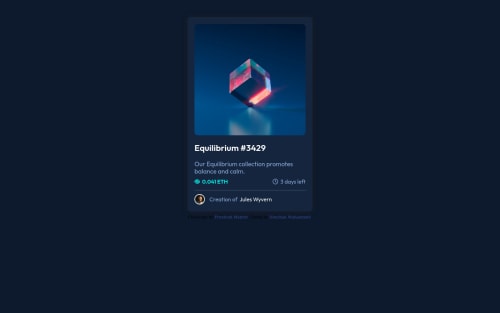NFT using html and css

Please log in to post a comment
Log in with GitHubCommunity feedback
- Account deleted
Hey there! 👋 Here are some suggestions to help improve your code:
- Do not forgot to check your FEM report, to see what is incorrect and update your code with it right after you submit your challenge.
- The NFT image
alt tagdescription needs to be improved upon. This is what your users are purchasing. Assume you’re describing the image to someone over the phone.
More Info:📚
https://www.w3.org/WAI/tutorials/images/
- The profile image
alt tagneeds to be improved. It should only state the following; “Headshot of -person’s full name-“
More Info:📚
- Wrap the "NFT image", "Equilibrium #3429" and "Jules Wyvern" in an
anchor tags. The anchor tag will allow users to click on content and have them directed to another part of your site.
More Info:📚
- To properly center your content to your page, you will want to add the following to your
body(this method uses CSS Grid):
body { min-height: 100vh; display: grid; place-content: center; }More Info:📚
[Centering in CSS][https://moderncss.dev/complete-guide-to-centering-in-css/]
- For improved accessibility 📈 for your content, it is best practice to use
remfor yourfont-sizeand other property value. Whileemis best formedia-queries. Using these units gives users the ability to scale elements up and down, relative to a set value.
If you have any questions or need further clarification, feel free to reach out to me.
Happy Coding! 🎄🎁
Join our Discord community
Join thousands of Frontend Mentor community members taking the challenges, sharing resources, helping each other, and chatting about all things front-end!
Join our Discord